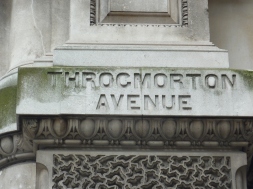 Yesterday’s post touched on the Drapers Company, so I think it’s time to start taking a look at the City of London livery companies, inextricably linked into London’s history and to many of its famous streets (or unusual street names). They are also linked to a common expression – ‘at sixes and sevens’ – and a curious pub name, both of which are explained later in this post.
Yesterday’s post touched on the Drapers Company, so I think it’s time to start taking a look at the City of London livery companies, inextricably linked into London’s history and to many of its famous streets (or unusual street names). They are also linked to a common expression – ‘at sixes and sevens’ – and a curious pub name, both of which are explained later in this post.
The Drapers Company has a hall at one end of Throgmorton Avenue; at the other end is the hall of the Carpenters Company. (To give them their proper names, they are the Worshipful Company of Drapers (number 12 in order of precedence, and we’ll get to that shortly) and the Worshipful Company of Carpenters (number 26).
Livery companies can be seen as early trade associations, incorporated under Royal Charter, with some of them dating back to medieval times. In 1515 an order of precedence was set, with the top 12 still referred to as the Twelve Great Livery Companies. Between 1746 and 1926 no new companies were created; those post-1926 are considered the modern livery companies.
The livery companies were powerful bodies in their time, regulating their respective trades and the practitioners of that trade. Interestingly, the original companies would seem to indicate the importance of textiles in medieval times: of the great twelve companies (see table below), five are textile related in some way; number 13 in order of precedence is the Worshipful Company of Dyers, and there is also a Worshipful Company of Weavers. The twelve great companies are:
- Worshipful Company of Mercers
- Worshipful Company of Grocers
- Worshipful Company of Drapers
- Worshipful Company of Fishmongers
- Worshipful Company of Goldsmiths
- Worshipful Company of Skinners/Merchant Taylors
- Worshipful Company of Merchant Taylors/Skinners
- Worshipful Company of Haberdashers
- Worshipful Company of Salters
- Worshipful Company of Ironmongers
- Worshipful Company of Vintners
- Worshipful Company of Clothworkers
The Skinner and Taylors have no fixed order of precedence; instead they swap annually between sixth and seventh. This comes about because of a long-standing dispute about which was granted a charter first; both received charters in 1327 but there is with no proof as to which was earlier. The dispute, apparently, eventually reached bloodshed and was taken to the Lord Mayor of London. He decreed that the respective Masters should be entertained to dinner by each other’s company annually and that each company should alternate the ranks of sixth and seventh from year to year.
This is often said to have originated the expression ‘at sixes and sevens’, (though some sources say it is more likely to have come from dicing).
So that’s the potted history of livery companies; now here are some connections, however tenuous, between the livery companies and some of the street names that have adorned this blog.
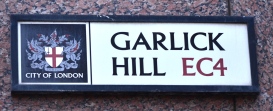 Garlick Hill, where the Worshipful Company of Leathersellers’ Company is based. The company is ranked fifteenth in the order of precedence and was founded by royal charter in 1444 with authority to control the sale of leather within the City.
Garlick Hill, where the Worshipful Company of Leathersellers’ Company is based. The company is ranked fifteenth in the order of precedence and was founded by royal charter in 1444 with authority to control the sale of leather within the City.
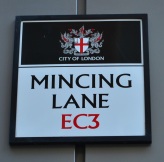 Mincing Lane, where the Worshipful Company of Cordwainers make their home in the Clothworkers’ Hall (their own hall was destroyed in the Blitz). The company, which was granted a Royal Charter in 1439, is one of the oldest, dating back to at least 1272. Cordwainers make “fine soft leather shoes and other luxury footwear articles”. The name comes from the soft leather, or cordwain, that its members used; this originated from Cordoba in Spain. And, yes, Jimmy Choo is a member of the Cordwainers.
Mincing Lane, where the Worshipful Company of Cordwainers make their home in the Clothworkers’ Hall (their own hall was destroyed in the Blitz). The company, which was granted a Royal Charter in 1439, is one of the oldest, dating back to at least 1272. Cordwainers make “fine soft leather shoes and other luxury footwear articles”. The name comes from the soft leather, or cordwain, that its members used; this originated from Cordoba in Spain. And, yes, Jimmy Choo is a member of the Cordwainers.
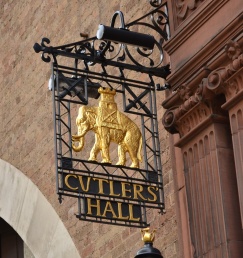 Elephant and Castle, where theories about its name include the emblem of the Worshipful Company of Cutlers (number 18 on the list). The Cutlers are now based in Warwick Street but their original hall (destroyed in the Great Fire of 1666) was in what is now Cloak Lane.
Elephant and Castle, where theories about its name include the emblem of the Worshipful Company of Cutlers (number 18 on the list). The Cutlers are now based in Warwick Street but their original hall (destroyed in the Great Fire of 1666) was in what is now Cloak Lane.
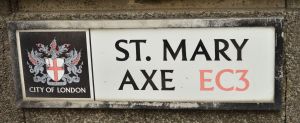 St Mary Axe, where the the John Stow Memorial Service is held in the church of St Andrew Undershaft. Stow was a member of the Worshipful Company of Merchant Taylors and that august body organizes the biannual service, which includes the ceremonial changing of the quill.
St Mary Axe, where the the John Stow Memorial Service is held in the church of St Andrew Undershaft. Stow was a member of the Worshipful Company of Merchant Taylors and that august body organizes the biannual service, which includes the ceremonial changing of the quill.
Threadneedle Street, once called Three Needle Street, has many theories as to the derivation of its name, not all of which are plausible. There is, presumably, a needle connection as The Merchant Taylors’ Company, which began as an association of working tailors, has had its hall here since at least 1347. There would probably have been tailors or needle sellers in the area and it could have been a shop sign. The Worshipful Company of Needlemakers does have three needles on its coat of arms, but the company did not in exist when the street was first called Three Needle Street.
The Swan with Two Necks (ok, cheating; it’s a pub name, rather than a street name, but so what? it’s a great name), which takes its name from the Worshipful Company of Vintners and the practice of swan upping. The Vintners, along with the Dyers and the ruling monarch, are the only people or bodies allowed to own swans on the Thames.
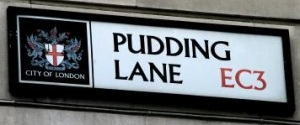 Pudding Lane, home to the first great hall of the Worshipful Society of Apothecaries (not a typo, it is the Society and not the Company). The hall, like so many other halls and London landmarks, was destroyed in the Great Fire of 1666 and was later rebuilt in Blackfriars Lane. The Apothecaries also have a connection with the British Museum and the Chelsea Physic Garden, which has an entrance in Swan Walk and therefore a connection with the famous Doggett Coat and Badge race, which is organized by the Worshipful Company of Fishmongers.
Pudding Lane, home to the first great hall of the Worshipful Society of Apothecaries (not a typo, it is the Society and not the Company). The hall, like so many other halls and London landmarks, was destroyed in the Great Fire of 1666 and was later rebuilt in Blackfriars Lane. The Apothecaries also have a connection with the British Museum and the Chelsea Physic Garden, which has an entrance in Swan Walk and therefore a connection with the famous Doggett Coat and Badge race, which is organized by the Worshipful Company of Fishmongers.
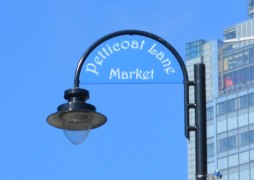 Weaver Street and Petticoat Lane, with connections to The Worshipful Company of Weavers, which, while it is number 42 in precedence, received its charter in 1155, making it the oldest recorded City Livery Company.
Weaver Street and Petticoat Lane, with connections to The Worshipful Company of Weavers, which, while it is number 42 in precedence, received its charter in 1155, making it the oldest recorded City Livery Company.
And last, at least for now, Ironmonger Lane, with connections to the Worshipful Company of Ironmongers (which has its hall in 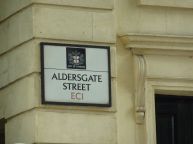 Aldersgate Street) and The Worshipful Company of Mercers, which has its hall in the lane. The first Mercers’ Hall was off Cheapside but was – you guessed it – destroyed in the Great Fire of 1666.
Aldersgate Street) and The Worshipful Company of Mercers, which has its hall in the lane. The first Mercers’ Hall was off Cheapside but was – you guessed it – destroyed in the Great Fire of 1666.
More on livery companies in the next (or at least a future) post.

11 responses to “London’s livery companies and street names”
I first learnt about livery companies by reading (as a child) Ring Out Bow Bells! by Cynthia Harnett. Her hero expects to be apprenticed to a grocer but is instead very upset to be apprenticed to a mercer. There was real rivalry between the companies and the apprentices used to fight each other. I re-read it recently and, like all her books, it stands the test of time!
A great overview of the livery companies. Despite your suspicions, I have little to add on the subject, which you covered very well.
Most enjoyable and informative.
Best wishes, Pete.
[…] ← London’s livery companies and street names […]
[…] London’s livery companies and street names. […]
[…] south of Fleet Street. Many ‘trade’ streets take their name from an association with one of the City Livery Companies, and Apothecary Street is one of […]
[…] Livery companies and street names: https://thestreetnames.wordpress.com/2015/02/10/1903/ […]
Like Helenajust I also read “Ring Out Bow Bells!” as a child and credit it with my current interest in medieval London. It was called “At the Sign of the Green Falcon” in the US. It would make a good film.
The Queen does indeed own unmarked swans on the Thames through her title of “Seigneur of the Swans” which has been absorbed into the Crown.
Just a minor correction: it’s the Vintners and the Dyers (not Drapers) who take part in swan-upping.
I must look into Cynthia Harnett – I never read anything of hers as a child or otherwise. Thank you for the heads-up on the Dyers versus Drapers – I’ve updated that post. I also found this snippet online: “In 2009 Her Majesty the Queen visited the royal custom of Swan Upping. Although she may own all unmarked mute swans in open water in Britain, she had never before made a personal visit to watch this ancient ritual.”
[…] random fact: the Livery Companies of London (which have direct connections with many street names) were also known as ‘mysteries’. From the Latin misterium, which in this instance roughly […]
[…] Livery companies and street names: https://thestreetnames.wordpress.com/2015/02/10/1903/ […]
[…] the livery companies, I have covered some of them in an earlier post, which touched on, among others, four of the twelve great companies: Drapers, Ironmongers, Mercers, […]